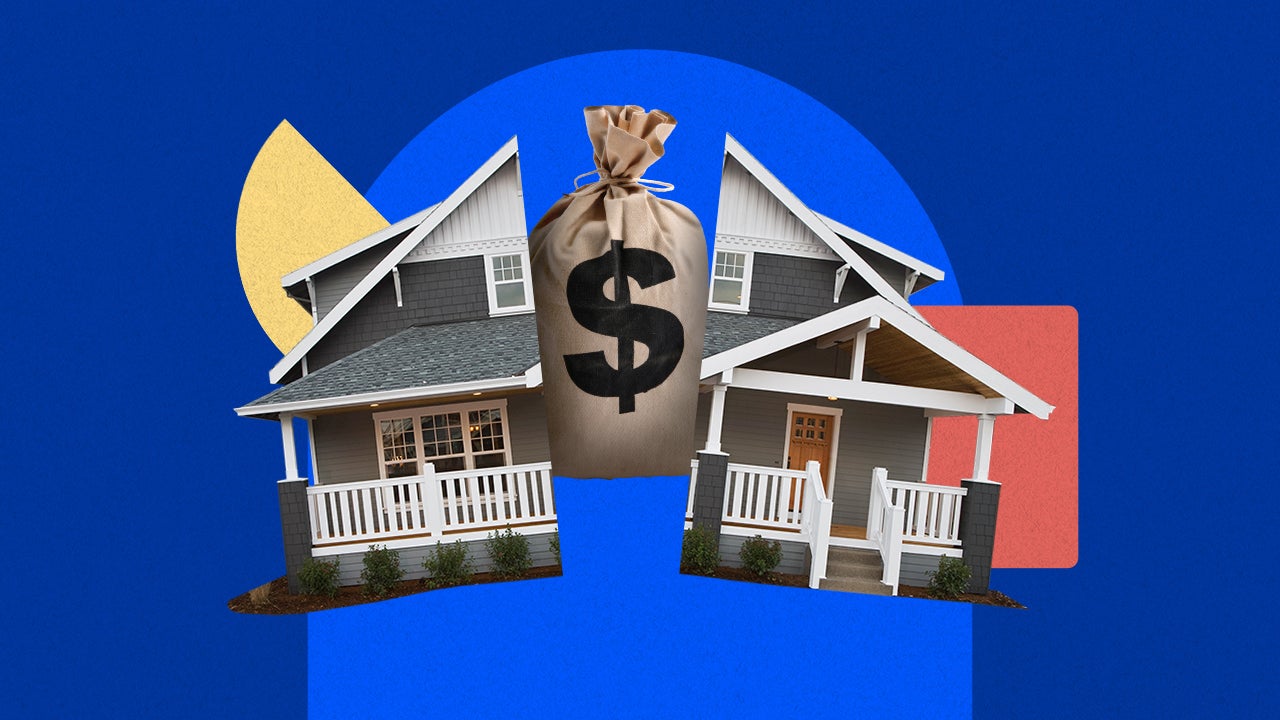Ask Bankrate: Questions about investing in real estate, tracking down stimulus and more

Ask Bankrate is a recurring feature where Bankrate’s experts answer your financial questions. Visit this page for more information on how to submit your question. Click on a question here to jump straight to it.
Questions:
- Is it a good time to refinance and invest in real estate?
- I haven’t received my stimulus check. What can I do?
- What should I do with an extra $1K?
- What low-risk investments offer better return than savings?
- What happens to savings if my bank fails?
- I’m about to retire. What’s a good strategy for diversification?
- Should I spread $250K-plus over multiple banks?
Q1: Is it a good time to refinance and invest in real estate?
Is it a good time to refinance a home or purchase rental property?
— Deshawn T.
Is it a good time to invest in real estate now that interest rates are low?
— Karen R.
Answered by Jeff Ostrowski, senior mortgage reporter: “The answer to both questions is unsatisfying: It depends. Now is a good time to refinance if you can save money by doing so. But six months from now might be an even better time. Mortgage giant Fannie Mae says rates could fall below 3 percent by the start of 2021. The National Association of Realtors envisions a similar scenario.
For homeowners considering refinancing their mortgages, those forecasts present a conundrum: Should you pull the trigger now? Or should you wait until later in the year, hoping that rates will fall below today’s 3.5 percent range and lenders will clear out a backlog of applications — while taking a risk that rates will move higher? In the past, as mortgage rates fell, the answer was always clear: If you can save a chunk of change on monthly payments, refinance now. Don’t roll the dice on the direction of interest rates. But the combination of the coronavirus and a flood of refinance applications has changed the rules.
‘These times are unusual in so many ways, one of which is that the urgency to jump on a refinancing opportunity right away before it disappears isn’t necessarily the case right now,’ says Greg McBride, CFA, Bankrate chief financial analyst. ‘In normal times, when rates drop and the refinancing door opens, it behooves borrowers to move quickly, as any reversal in rates could slam the refinancing door shut.’
With U.S. unemployment near record levels and the country still partly shut down, these are anything but normal times. The economic recovery could drag on, and almost no one predicts a spike in mortgage rates in the near future.
There’s also this wild card: Lenders have been so inundated with refinance applications that they’ve kept rates higher than would be the case in normal times to quell demand. By waiting, you could save more — but you also take the risk that rates will rise.
As for investing in rental property, that’s also a judgment call. For every landlord who has profitably owned a rental property, there’s another who regrets trying. Here’s one good reason to invest in rental property: Some housing economists say the coronavirus recession will make housing less affordable, and therefore will create demand for rental housing. What’s more, the pace of new construction since the Great Recession has lagged demand. On the other hand, as a landlord, you’re at the whim of the local economy, and you face myriad risks, including natural disasters and deadbeat tenants. And while home prices and rents are likely to keep rising in the long term, the spate of unemployment and mortgage delinquencies this spring raises questions about the short-term direction of the housing market.”
Q2: I haven’t received my stimulus check. What can I do?
Why haven’t I received my stimulus check yet? What steps do I need to take?
— Clinton J.
Answered by Sarah Foster, U.S. economy reporter: “Tracking down your stimulus payment can definitely feel like a cat-and-mouse game. But if you’ve already double-checked that your income lies within the threshold of eligibility (that’s less than $75,000 in annual adjusted gross income for single adults and $150,000 for married couples), the reason you haven’t yet received your payment most likely has something to do with your bank account. Perhaps you submitted your 2019 or 2018 taxes (the report that the IRS bases eligibility on) without your direct deposit information; maybe the bank account you submitted for those reports is no longer active. Unfortunately, the deadline for inputting and updating that information through the IRS’ Get My Payment tool has passed, but it’s still worth using.
I’d first suggest plugging your information into the system to check on your payment status and schedule. In most cases, you’ll get your $1,200 (or more) in the mail, either through a paper check or a debit card. That’s likely going to take a while, though, as the IRS is prioritizing whose monies are mailed first, with the last payment set to disburse Sept. 4. For even more ways to keep tabs on that payment, consider signing up for Informed Delivery, a tool offered through the U.S. Postal Service that scans an image of your mail before it’s delivered.
Of course, there are some other rarer, more extreme scenarios. If you filed your taxes with a third party and received an advance on your refund, that stimulus check might be going to the wrong account. Don’t panic, though; it’s going to get fixed. The bottom line is, it pays to be patient and informed. Stay up to date on ways to protect yourself against fraud, and don’t be afraid to contact the IRS if September rolls around and you still haven’t received your payment.”
Q3: What should I do with an extra $1K?
If I have $1K to spare, do I put it in savings, pay down a credit card or invest in stocks?
— Melissa P.
Answered by Stephen Kates, CFP: “Planning what to do with your surplus money should be thought of as a hierarchy. As you check off the early stages, you can advance to the next level. The very first step is making sure your essential expenses are covered. It sounds like you are already past this stage, which already puts you in a great position.
Second, consider the state of your emergency fund. Is this adequately funded? At a minimum, you should have one month of essential expenses set aside for emergencies, but ideally you can build this up to between three and six months of expenses. If your emergency fund is not at a comfortable level, focus your money here because this will protect you from any surprises that could set you back even further in the future.
Third in line will be any ongoing credit card balance or other high-interest debt. The sooner this can be paid down, the more flexibility and surplus cash you will have for investing goals later on. Leave stocks and other non-retirement investments for when you have eliminated any high-interest debt, as the interest rates can easily exceed the expected return from even the most aggressive investments.”
Q4: What low-risk investments offer better return than savings?
I recently sold an investment property and have the cash invested, most of it in online banks. I have never invested in the stock market. (I have a low risk tolerance.) What would be a good investment now for a better return than a savings account?
— Ronald
Answered by Stephen Kates, CFP: “While sticking with low-risk investments may not give you flashy returns, it will give you peace of mind, which could be worth just as much. Savings accounts and CDs will likely be the most convenient options for you since you are already acquainted with online banks. (You can check rates here: Savings and CDs). Current rates for savings accounts and short-term CDs are very similar, while longer term CDs will have an edge when it comes to interest rates. While an extra 0.25-0.50 percent might be tempting, consider carefully the liquidity risk you would be taking on by committing to multiple years in a CD. Liquidity is your ability to access the money you have invested. Savings accounts are very liquid, while selling a CD before its expiration could incur a penalty. If you need access to your money often, you may want to stick with your savings accounts so you don’t risk a premature sale.
If you want to look beyond the online banks, there are other conservative options available that you can consider. For each of the following options, you should research them carefully or speak to a trusted adviser to make sure you have a firm understanding of how they work before investing. The shorter your investment time frame, the simpler your investment should be. When in doubt, stay with what you know to maintain your peace of mind.
Individual bonds: Bonds are debt owed to you by a company or government. Like CDs, they have a maturity date when the investment will end. Most bonds will pay semi-annual interest and will return your original investment at the end of the term. While conservative, bonds are only as good as the creditworthiness of the issuing institution. Bonds can be sold prior to maturity, but the sale value is subject to prevailing market prices.
Bond mutual funds: Bond mutual funds are a collection of bonds packaged together by an investment company and sold to many investors such as yourself. A diversified portfolio of bonds can limit the risk of concentration and increase the overall return, but the trade-off is that the value of the mutual fund will fluctuate on a day-to-day basis.
Fixed deferred annuities: Fixed deferred annuities are products that offer a guaranteed rate of interest for a defined period of time. While CDs are backed by FDIC insurance, annuities are backed by the insurance company itself, so it is important to research the company ratings. Unlike CDs, deferred annuities accumulate interest on a tax-deferred basis, and you will owe taxes only on the interest earned at the time you withdraw the money instead of in the year it is earned. Lastly, when it comes to annuities, read the contract carefully and do your research, as these products can vary from company to company in regard to their terms and costs.”
Q5: What happens to savings if my bank fails?
If the money invested in an online savings account is more than $250,000 and the bank fails, will all the money be lost or above $250,000?
— Frazer D.
Answered by Stephen Kates, CFP: “If you have more than $250,000 in a single account at one bank, the amount of money over $250,000 would be at risk since FDIC insurance only covers up to $250,000 per registration at a given bank. However, it is very simple to eliminate this risk by spreading out your money.
Here are two examples of how to protect more than the $250,000 limit.
- Using different registrations within the same bank: If you are married and have a joint account, each spouse will each have $250,000 of FDIC protection for a total of $500,000. Additionally, if you have a separate individual account, that also has its own $250,000 of FDIC protection.
- Using different banks: If you have three individual accounts at separate banks, you will have $250,000 of FDIC protection at each bank. Some companies offer what is called a FDIC-Insured Deposit Sweep account, which automatically does this bank allocation work for you so you don’t have to set up separate accounts at different institutions.”
Q6: I’m about to retire. What’s a good strategy for diversification?
I plan to retire in a year. I was about to invest in an annuity tied to the market, but now I’m hesitating. What’s a good strategy for diversification now?
— Maggie M.
Answered by Stephen Kates, CFP: “Annuities can be complicated products and deserve careful consideration before signing the contracts. It’s normal to feel trepidation when making such a big decision for your life. In order to make the right decision for you, think through what attracted you to this particular annuity in the first place. Annuities can provide welcome stability to a retirement plan just like a traditional pension. If income stability is what you are seeking, an annuity can supplement other guaranteed income sources such as Social Security. I typically recommend that retirees try to cover their essential expenses with guaranteed income (from pensions, Social Security or annuities) but not tie up all of their assets in annuities or pension plans because it can leave them with too little flexibility.
Index annuities, which are typically benchmarked to the stock market, offer to let you participate in the upside of the market while eliminating the downside risk. This can be especially enticing during times like these when the stock market feels very unstable. However, it’s worth noting that the regulatory body FINRA has issued an alert to investors who are interested in index annuities. Their complexity and cost can be reason to take extra care before signing a contract. This type of annuity is only one of many, and if you are interested in the comfort of guaranteed income, a simpler life-only annuity could be an option worth considering.
Putting annuities aside, there are other options to create income diversification. While not completely guaranteed, building a fixed income portfolio using either individual bonds or mutual funds can create a dependable income stream. Stocks, while more volatile, can also create an income stream through dividends. All of these options are valid and useful as a part of a holistic retirement plan. As you think through how you want to proceed, speak to an advisor who knows you and your goals and can help advocate for your plan. Good luck!”
Q7: Should I spread $250K-plus over multiple banks?
I have more than $250K to invest. Should I put it in different banks or in different CDs in the same bank?
— Valerie W.
Answered by Matthew Goldberg, consumer banking reporter: I commend you for taking this step to make sure your money is protected. Everyone who is fortunate enough to have anything near $250,000 or more in an FDIC-insured bank, or multiple FDIC-insured banks, should use the FDIC’s Electronic Deposit Insurance Estimator (EDIE).
The FDIC’s standard deposit insurance amount is $250,000 per depositor, per insured bank, for each ownership category. EDIE helps you determine what amount is insured and if any of your money exceeds FDIC coverage limits. EDIE only provides an accurate estimate if you enter in all of your bank accounts. FDIC’s BankFind is another great tool to help you confirm your bank is FDIC-insured. It also might help you realize if multiple banks use the same FDIC certificate.
You should also contact your bank and call the FDIC if you have any additional coverage questions.
Featured image by Getty Images, illustration by Bankrate.
Why we ask for feedback Your feedback helps us improve our content and services. It takes less than a minute to complete.
Your responses are anonymous and will only be used for improving our website.



